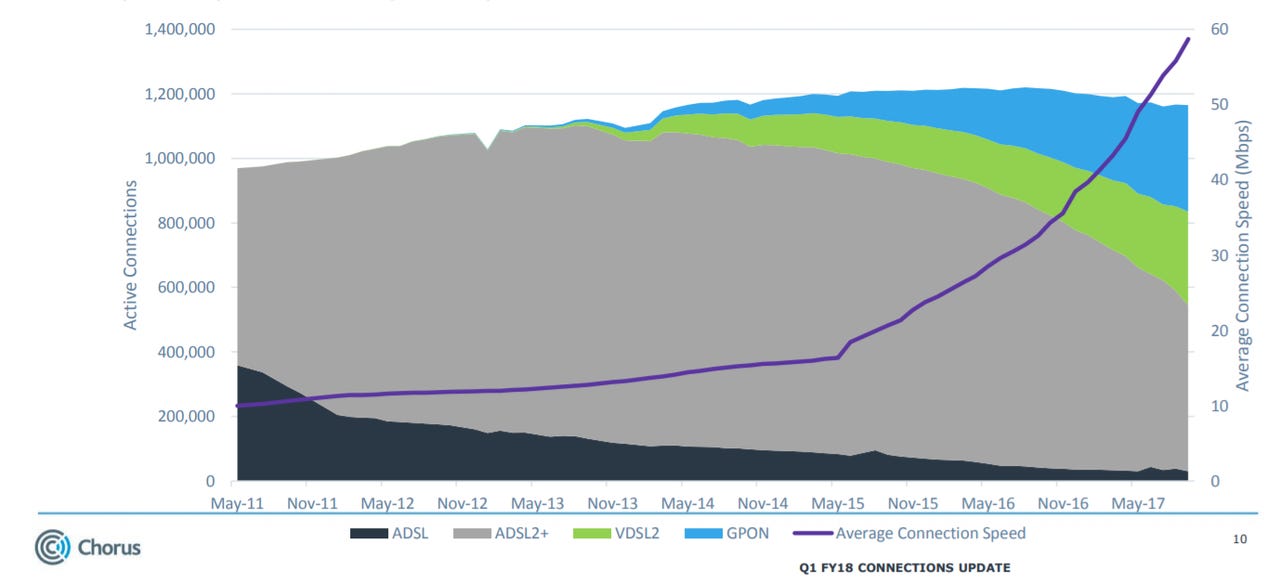Chorus: 70 percent of fibre connections on 100Mbps speeds


New Zealand incumbent telecommunications provider Chorus has announced that a majority of its fibre broadband connections are now on plans of 100Mbps or higher, with 309,000 connections now made within its Ultra-Fast Broadband (UFB) footprint.
There has been a 39 percent uptake of fibre across the country, with 585,000 premises now passed out of a total of 1.054 million to be passed by the end of 2022, and 784,000 customers able to connect.
Of all mass-market fibre plans, 73 percent are on 100Mbps or more, with Chorus saying 50Mbps plans are now reducing after the telco introduced gigabit-speed plans a year ago.
As of September 30, Chorus had 1.1 million total connections in UFB 1 and 2 areas; baseband copper and copper ADSL services decreased as fibre and VDSL connections increased, which Chorus said was due to its "Ask for Better" campaign making consumers aware of higher-speed options, along with its fibre migration trials.
"Fibre migration trials yielding results: 70 percent of customers spoken to agreed to connect their homes at the same time as the street rollout in Hokitika; 40 percent of customers in an Auckland neighbourhood, whom hadn't yet connected to fibre, agreed to have their homes connected when approached by Chorus," Chorus said.
With 53 percent of all Chorus broadband connections now on VDSL or fibre, average broadband speed increased from 33Mbps in September 2016 to 59Mbps in September 2017.
The average 9pm network throughput speed during September was 1.24Gbps in September 2017, up from 1.084Gbps in June 2017.
According to Chorus the average lead time for a fibre connection is now 14 days, down from 22 in June, with 27,000 work-in-progress connections as of September 30.
The three-month average customer satisfaction score for installation was 7.4 as of August.
Chorus had in January announced that it would be extending the UFB to 169 new areas and 203,000 premises across the country.
Under UFB2, Chorus intends to pass 5,000 premises in FY18; 26,000 in FY19; 33,000 in FY20; 29,000 in FY21; 23,000 in FY22; 25,000 in FY23; 21,000 in FY24; and 6,000 in FY25, with construction beginning in July this year.
Chorus also partnered with Spark in November last year on the latter's "street in a week" fibre installation program, offering consumers in certain areas a rapidly deployed fibre upgrade from their legacy copper service.
Chorus at the time said it was willing to work with retail service providers to provide fibre broadband connectivity on connecting customers in a faster way.
The program was introduced in response to the sector being plagued with complaints about delays in connecting fibre broadband services. Through the program, customers will be able to select a specific day within a specified week to have their fibre broadband service installed. This will remove the middleman local fibre companies (LFCs), with customers no longer having to enter a queue to be served by these LFCs after placing an order with their retail service provider.
"Every month, Spark logs around 30,000 requests with Chorus for customers who report faults on their broadband or landline services that rely on a Chorus copper line connection -- and these volumes increase over the wet winter months. It is not uncommon for some unfortunate customers to experience multiple faults within a few months, each requiring investigation by Chorus technicians," Spark said at the time.
In October 2016, a report on telecommunications complaints by the Telecommunications Forum (TCF), made up of telco operators across New Zealand, revealed that consumer complaints about delays in connecting premises to UFB fibre had skyrocketed.
"The typical complaint is that the scheme member signs the customer up to the fibre service with an indicative commencement date. This date passes with no service being connected," the report said.
"It appears that the scheme members, in notifying the installation date, rely on information provided by the fibre installation companies. The installation companies do not then complete the work on time."
Chorus a year ago boasted that it has shortened the length of time that consumers are waiting for their fibre to be connected, from 16 days in the July 2016 quarter down to 12 days on average.
Chorus had added that customers in Auckland are waiting just six business days for their connections to be made now, with the telecommunications provider attributing the uptick in "fibre productivity" to signing on Visionstream as its primary connector.
Chorus' UFB rollout involves a fibre-to-the-premises (FttP) network for 80 percent of the nation, while the Rural Broadband Initiative (RBI) will provide broadband for the remaining 20 percent of the New Zealand population.
The New Zealand government is targeting 99 percent of the population with 50Mbps minimum broadband speeds by 2020, with the remaining 1 percent to have speeds of at least 10Mbps.
By comparison, Australia's National Broadband Network (NBN) will provide the nation with minimum guaranteed speeds of 25Mbps by 2020.
According to NBN's Corporate Plan 2018-21, 3.1 million Australian premises will be connected with HFC, while 1.9 million premises get FttP, 4.6 million get fibre to the node (FttN) or fibre to the basement (FttB), 1 million get fibre to the curb (FttC), 600,000 get fixed-wireless, and 400,000 get satellite.